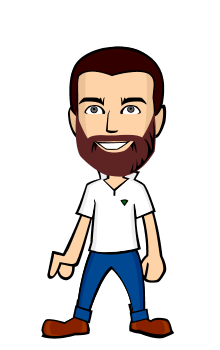So today I am going to be talking about some of the pre production I am doing for my next short film. I will follow this for the next few weeks and by the end it should have created an in depth guide you could follow. I will use example documents from past films to help show the process.
SCRIPT
So the first thing I did was come up with the script. I wanted to do a short snappy film that only lasts a couple of minutes. Most people don’t have the time to sit down and watch longer short films; people browse the Internet in their spare time and in between doing other things. Having something nice and short will more likely entice the general viewer.

When writing a script I know that as a rough guide one page of script relates to one minute of film. Like I said in my previous blog you can get a great piece of scriptwriting software online, just Google Celtex. Below you can see an example from ‘Falling’ remember each scene starts with EXT or INT telling the viewer if the scene is external or internal. Followed by the name of the location and finishing with the time of day. Something you should do that I haven’t done here is give the characters a brief description.
Scripts can continue to have changes right up until the shoot so it’s important that you send it out to people and get feedback. If anyone would like to see the script I am working on to give feedback then please feel free to get in touch.
BREAKING THE SCRIPT DOWN
The next thing I do is just a rough document breaking the script down in to scenes, props and characters. This will help me to understand how much time I will need to shoot and aid in the schedule. If you have a bigger script then I would go through it with different colored highlighters and mark down props, locations and maybe characters. On a bigger film with more crew you would have an art department who would do this and a costume department. But on shorts you have a limited crew and it’s always good to understand the process.

SHOOTING SCRIPT
This breaks the script down in to two columns, audio and video. It kind of works with your script being transferred to the audio column then a text version of a storyboard in the other half. I have not used my current film’s shooting script because I don’t want to give the film away before the release. If you check out the sample below you will see the format required. This is a template taken from adobe story.

MOOD BOARDS
So far with my film I have only done a mood board for the makeup artist. You could do one for any visual department of the film however because I am shooting my own film I don’t feel it necessary. I sent this to my makeup artist with some notes but the idea is by looking at the mood board she should have an understanding as to what I’m after. As a camera man/DOP I really find it useful to either have a mood board or a collection of examples to see before the shoot as it gives me a greater understanding as to what the director wants.
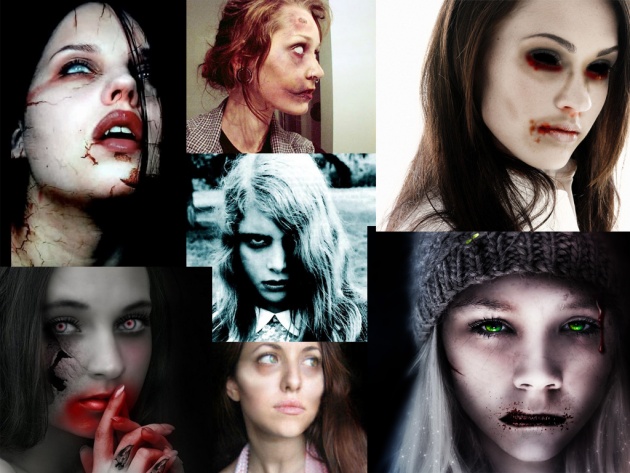
CASTING
Ok with this film I have been lucky enough to cast an actress I know however I would usually go through the casting process. This is incredibly important and something I am still learning. You could hire a casting director if the budget allows who will find you people to come and audition. If the budget will not allow then try Starnow and Casting Call, these have a huge amount of people with various degrees of experience.
Organizing casting can be a long and difficult. Something you could do is hold open audition where people don’t have a specific time but instead turn up when they want to. However sometimes you may want specific people to audition together and so you would need them to arrive at the same time. I will try to hold two rounds of audition and call people back a second time. This is where you could put people in pairs, but really it’s for me to make absolutely sure I am making the correct decision.
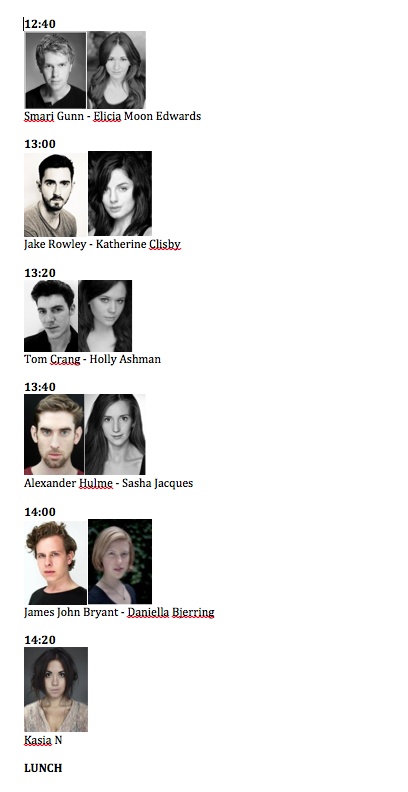
Its good to have a plan of your audition, what you need to ask and even break it down in to a time frame. I usually try to have at least three people in my audition to give feedback. Then I will film the auditions to look back on later. Make sure you tell the people auditioning that you are filming to make sure they don’t mind. Its good to film people as this gives you an idea how they will react to a camera (in case some people are less experienced than others)
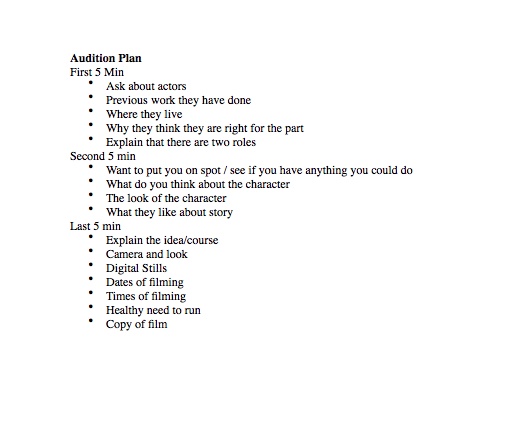
Try to find somewhere professional to hold the auditions. This will give the people auditioning a better impression of you. If you are only covering expenses then you are basically selling the film to the people auditioning, so make sure you give a good impression. You want the people involved to go the extra mile for you!
SHOOT DATES
I like to do this early on in my project so that I have something to work towards. I selected three possible dates when I was contacting cast and crew in the beggining and have now pinned it down to the exact day. I think that its vital you have some form of calendar to work from. I used to have a big one across my wall however now I work from a digital version.
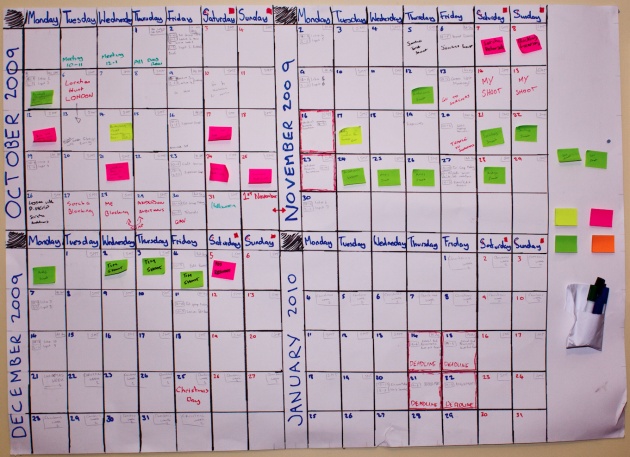
CREW
Getting your crew can be difficult. You could look for people on Starnow or Mandy or a host of other sites out there. Ultimately you want to build good relationships with the people you work with because this industry is so small the chances are you will run in to them again. Its give and take, people come and work for you when you need them and likewise you give back when they need you. Filmmaking is teamwork so check out other members of film annex or write a blog post about your film and needing crew. It all comes down to how well you can sell your film, unfortunately having a great idea isn’t always enough, you need to be able to sell that idea to others to get them interested.
It’s a good idea to get people early on, if you have a composer then get them involved before the shoot so they can start working on the piece as soon as possible. Send them examples that you like, show them the script so they know the feel of the film.
BUDGET
Have an idea of your budget before you shoot. Give specific areas budgets such as kit, location, props and any areas you need. Give yourself a contingency budget incase you need to go over. Not having a budget before you start could really increase the cost of a film because you are not giving yourself a limit. Costs can mount up so you need to keep everything in order. You are far more likely to be able to blag things for free if you can show someone that your budget will not allow you to spend much.
This is an old template but it’s a basic one that you could use, I would go in to greater detail now and break it down in to more sections.

SHOT LIST
A shot list is your story broken down in to a simple to follow order in which you shoot. You can see its easy to follow, color coded to show the actors in each shot and also a time frame for each shot. I will give this along with the relating storyboard to the members of crew who need it so that they know what were shooting without me telling them.
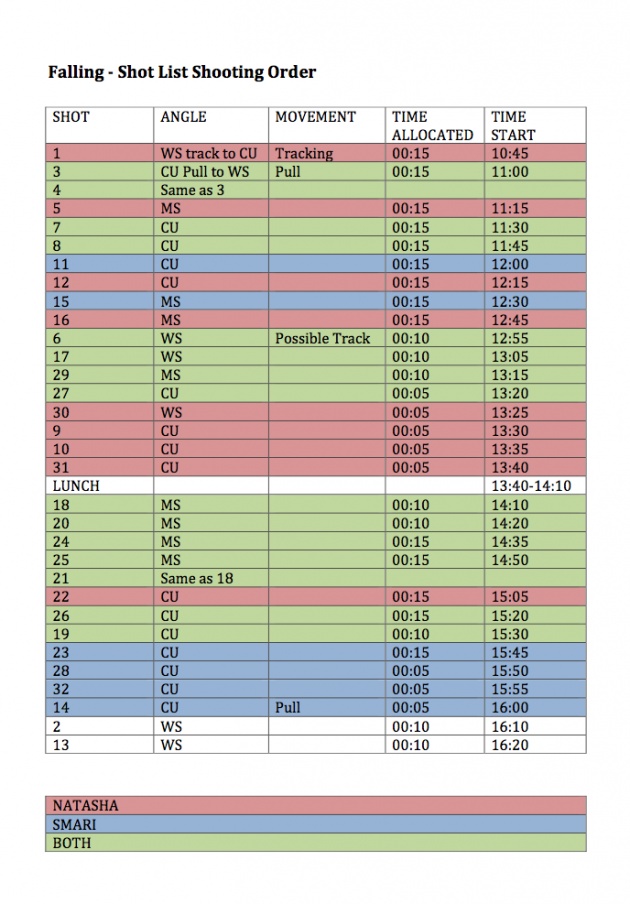
STORYBOARD
This is your film in visuals with a brief text description. Below are the storyboards we used on Falling; you can see I used actual photos, which I took at the rehearsals. I generally go through two drafts, the first being very rough and the second being photos to make it more understanding to the DOP.
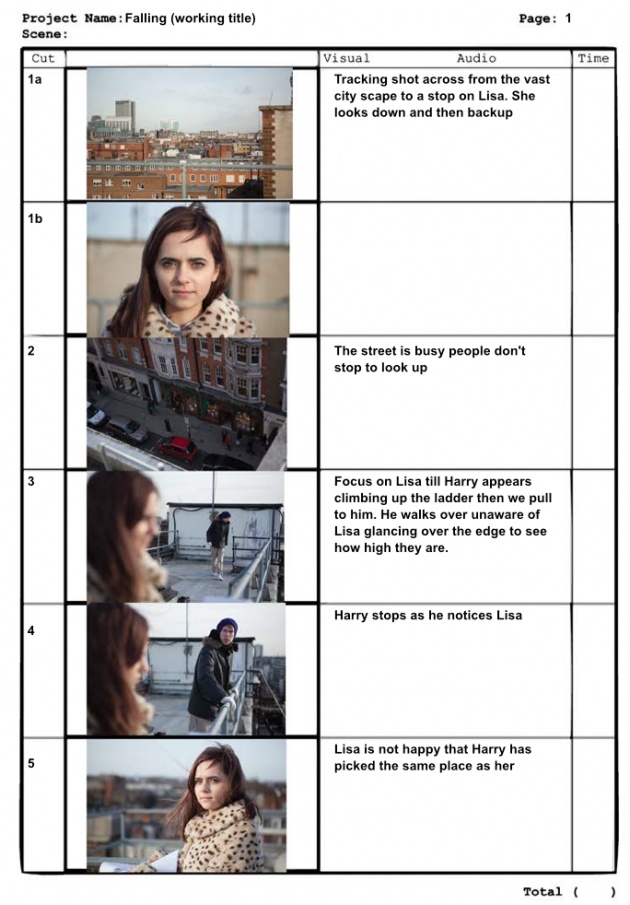
FLOOR PLAN
This is just a rough version that I have taken from Ready or Not. I would try to draw to scale now and use different overlays to show specifics. If you start with your basic out line of the floor done with black ink. Then you could have three overlays done on tracing paper. Once with camera positions, the second lighting plan and finishing with actor movements.

CALL SHEET
To finish off with I just want to leave you with probably the final document you will do before a shoot, which is the call sheet. This is something that everyone does different and something I have been refining over the years. I believe a call sheet should be no more than one page. It should have the main crew and cast needed for the day and a brief schedule. The weather forecast with the location and phone number of the local emergency services.

Stay tuned for more info about my upcoming short film, shooting on the 17th Novemeber!

